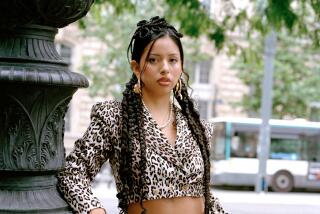Portrait of Latinos as evolving artists
- Share via
GOLDENDALE, Wash. — Ten years ago, artist Cristina Acosta modeled her work after live sketches. What she saw, she painted. The results reflected her emotions, but not her imagination.
Today, the arabesque flourishes in her still lifes remain, but bold images of bears, owls, fish and eagles dominate. Intertwined metallic leaf pays homage to the gold and silver filigree her family created in Mexico decades ago.
The works point to a woman who has grown more comfortable with herself, as a Latina artist in the Pacific Northwest.
“Ten years ago, I was much more of a minority than I am now,” she says. “I think in those days, I didn’t delve into my inner world as much. That’s probably the big difference from where I am now and where I was then as an artist. I’m much more integrated.”
Acosta, of Bend, Ore., is one of several artists featured in “People, Places and Perceptions: A Look at Contemporary Northwest Latino Art,” a new exhibit at the Maryhill Museum of Art. For the first time, the museum celebrates Latino artists and shows how their work has evolved in the years since they moved to the Pacific Northwest.
Jose Orantes of Seattle painted women in colorful folk dresses in his native Guatemala. Today, the bright colors remain but the subject matter is vastly different: His work is a study of transportation in Puget Sound. Cars, highways, ferries and marinas on a tilted horizon represent frenzied life in a metropolis.
In her native Mexico, Almendra Sandoval photographed men working in farm fields, women performing chores and children living in poverty. A move to Seattle in 2001 shocked Sandoval with the abundance of the Pacific Northwest.
“Not just the abundance of things like plants and animals, but the abundance of opportunities she sees for personal growth,” said Lee Musgrave, curator of contemporary exhibitions at Maryhill, pointing to Sandoval’s newer photographs, largely nudes, of women in youthful, natural settings.
The exhibit is one Musgrave has been pursuing since he arrived at Maryhill a decade ago, and it comes as the region’s Latino population is skyrocketing.
Washington state’s Latino population more than doubled during the 1990s, and in 2002, it was estimated at more than 490,000 people. Oregon’s Latino population has been estimated at more than 320,000, according to U.S. Census figures.
But the artists most want to be valued for their work and initially balked at being identified as Latino for the exhibit, Musgrave said. “At the same time, you want to place some value in the background these artists bring with them and how their new environment changes their outlook,” he said.
The work of Gloria de los Santos serves as a perfect example, Musgrave said.
A highly trained photographer from Chicago, she moved to Kettle Falls, Wash., five years ago. Her earlier work focused on X-ray skeletal images. Today, she makes cyanotypes -- shooting pressed and dried plants and flowers by placing them on a sensitized photographic plate. It is a process that was used more than 150 years ago.
“I knew that I wanted to preserve and keep and infiltrate them into my art somehow,” De los Santos said about the plants.
Other artists’ work more directly reflects their heritage.
Jose Luis Rodriguez Guerra, originally from Mexico and now living in Seattle, draws on spirituality in his paintings of solemn, lone figures on wooden boxes with rounded edges. Acosta takes particular pride in a Madonna bear painting, which is reminiscent of altarpieces Latino artists often make for their own homes.
“To see these cultural gifts to the Northwest recognized at the museum level is a significant symbol of the growth of the community at large,” she said.
The Maryhill Museum exhibit will be on view through Nov. 15.
More to Read
Sign up for Essential California
The most important California stories and recommendations in your inbox every morning.
You may occasionally receive promotional content from the Los Angeles Times.










